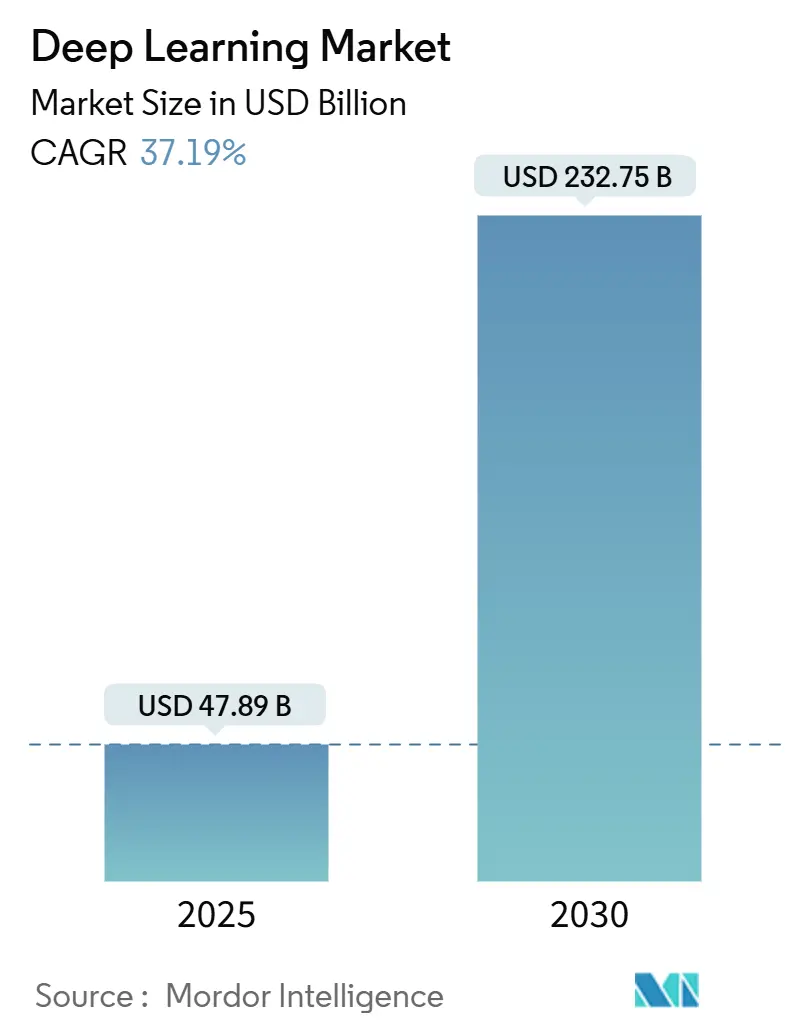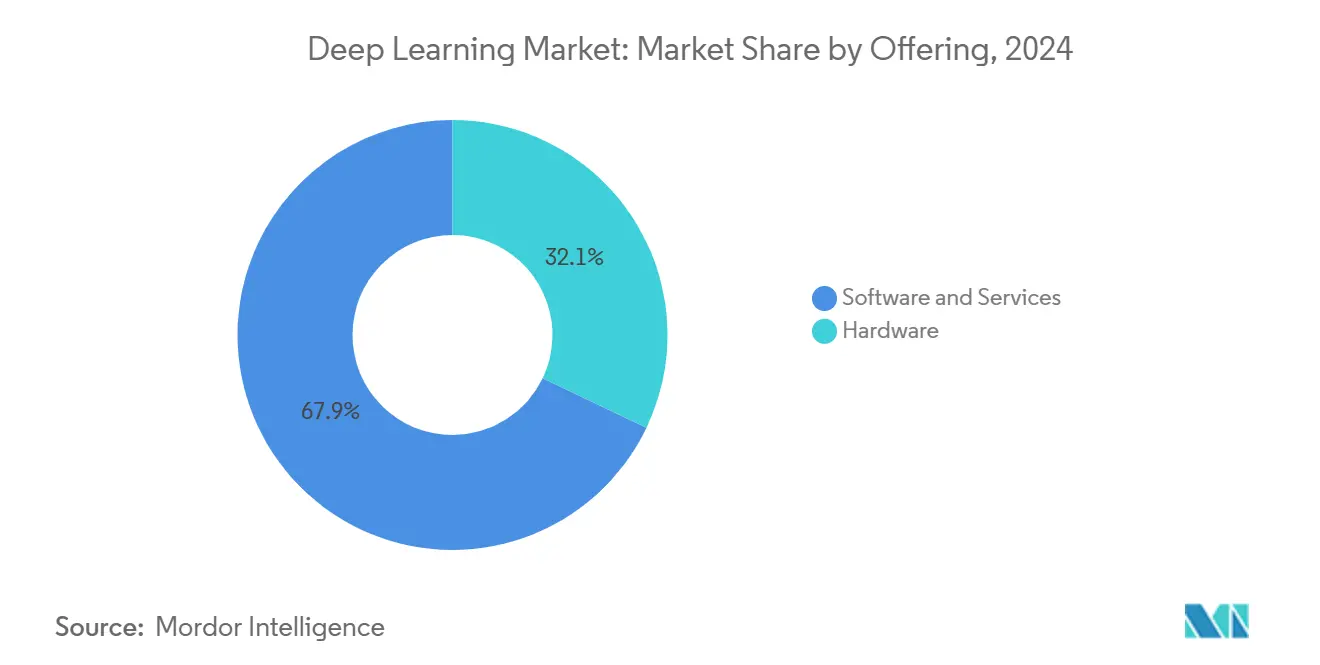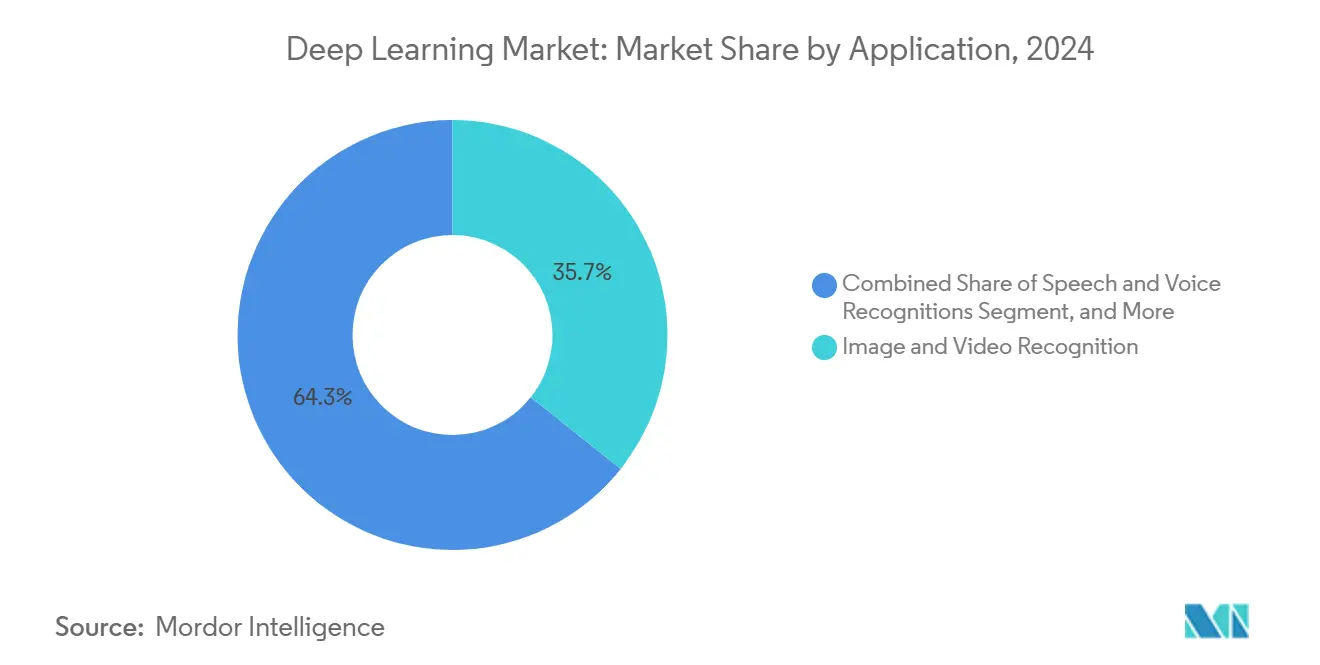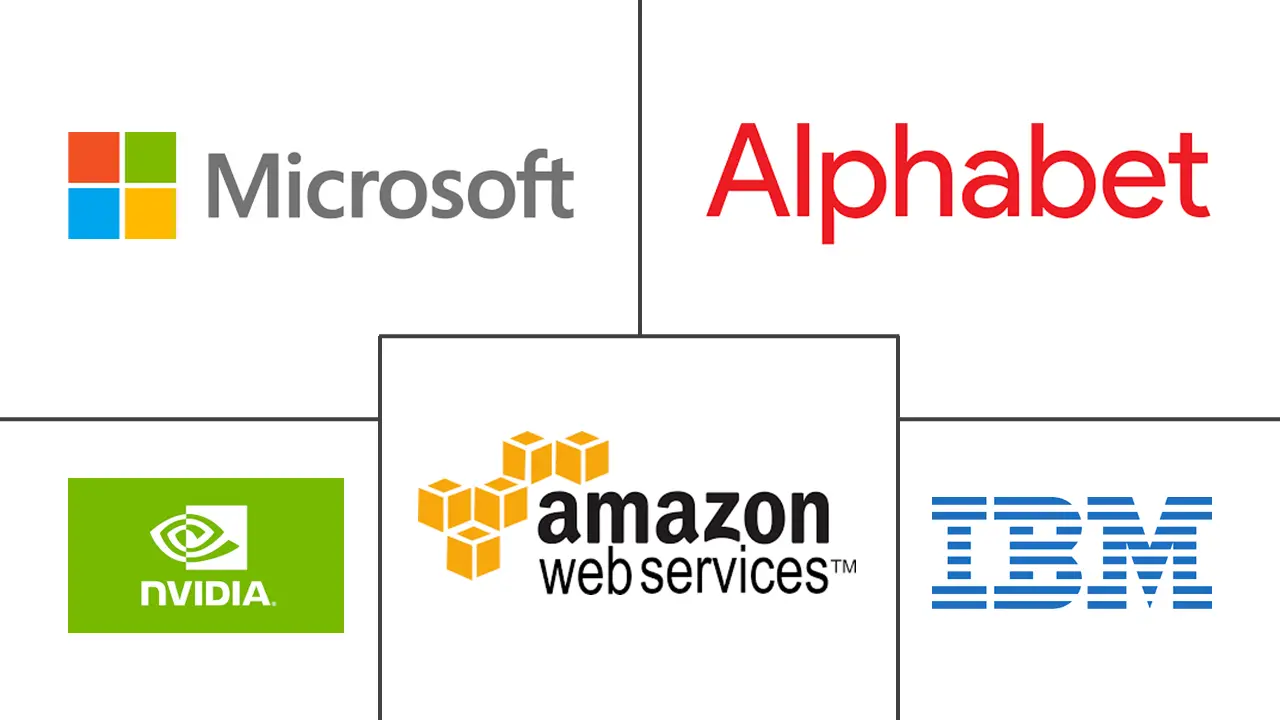Deep Learning Market Size and Share

Deep Learning Market Analysis by Mordor Intelligence
The deep learning market size is estimated at USD 47.89 billion in 2025 and is projected to reach USD 232.75 billion by 2030, advancing at a 37.19% CAGR. Hardware accelerators now deliver larger models at lower latencies, while transformer breakthroughs accelerate adoption across every industry. Financial institutions, hospitals, manufacturers, and retailers embed neural networks directly into workflows instead of confining them to research labs. Hardware vendors, cloud platforms, and software specialists form new alliances that reduce time-to-deployment for enterprise buyers. At the same time, energy use, regulatory scrutiny, and skills shortages challenge the pace of scale-out.
Key report Takeaways
- By offering, Software and Services held 67.9% of deep learning market share in 2024, while Hardware is forecast to expand at a 37.5% CAGR through 2030.
- By end-user industry, the BFSI sector led with 24.5% revenue share in 2024; Healthcare and Life Sciences is projected to grow at a 38.3% CAGR to 2030.
- By application, Image and Video Recognition accounted for 35.7% of deep learning market size in 2024, whereas Autonomous Systems and Robotics will advance at a 38.7% CAGR through 2030.
- By deployment mode, Cloud solutions captured 62.1% share of deep learning market size in 2024 and are set to grow at 39.5% CAGR to 2030.
- By geography, North America commanded 32.5% of the deep learning market in 2024, while Asia-Pacific is forecast to post the fastest 37.2% CAGR between 2025 and 2030.
Global Deep Learning Market Trends and Insights
Drivers Impact Analysis
| Driver | (~)% Impact on CAGR Forecast | Geographic Relevance | Impact Timeline |
|---|---|---|---|
| Explosive growth in unstructured data volumes | +8.20% | Global, with concentration in North America and Asia-Pacific | Medium term (2-4 years) |
| Declining cost and performance leap of AI accelerators | +7.80% | Global, led by US and Taiwan semiconductor hubs | Short term (≤ 2 years) |
| Consumer-grade DL integration (voice, vision, IoT) | +6.40% | North America and Europe early adoption, Asia-Pacific mass market | Medium term (2-4 years) |
| Medical-imaging and diagnostics adoption surge | +5.90% | North America and Europe regulatory leadership, global expansion | Long term (≥ 4 years) |
| Vertical foundation models unlocking niche markets | +4.80% | Global, with enterprise concentration in developed markets | Medium term (2-4 years) |
| Edge/on-device DL for privacy and ultra-low latency | +3.70% | Europe privacy-driven, Asia-Pacific manufacturing applications | Long term (≥ 4 years) |
| Source: Mordor Intelligence | |||
Explosive Growth in Unstructured Data Volumes
Every day enterprises generate 2.5 quintillion bytes of information, and roughly 80% of that data remains unstructured. Optical neural processors now reach 1.57 peta-operations per second, enabling real-time video, audio, and text analysis for autonomous systems and industrial monitoring. Financial institutions report a 300% increase in alternative data feeds, including satellite imagery and social sentiment, which demands specialized models able to correlate disparate sources. Edge computing deployments rise 34% year over year as firms shift from batch analytics to low-latency inference. The resulting feedback loop boosts model accuracy while expanding addressable workloads.
Declining Cost and Performance Leap of AI Accelerators
Advanced 3-nanometer designs, stacked HBM memory, and photonic interconnects push compute costs down by 40% annually. NVIDIA’s Blackwell Ultra delivers 1.5× performance over its prior generation.[1]NVIDIA Corporation, “Introducing the Blackwell GPU Architecture,” nvidia.com AMD’s MI350 series posts 35× throughput gains versus earlier chips . These leaps allow mid-market companies to run 100-billion-parameter models on single-node systems instead of distributed clusters. Lower capital outlays widen the customer base and shorten procurement cycles, turning hardware into the fastest-growing deep learning market segment.
Consumer-Grade DL Integration
AI PCs, smart cameras, and voice assistants generate billions of daily interactions, producing massive fine-tuning data while driving demand for on-device inference. Apple allocates USD 1 billion to new AI infrastructure, and analyst forecasts show AI-capable PCs will represent 80% of shipments by 2028. Qualcomm’s Snapdragon X Elite reaches 40 TOPS on handheld devices, letting users perform advanced NLP and vision tasks without cloud connectivity.[2]Qualcomm Incorporated, “Qualcomm On-Prem AI Appliance Solution,” qualcomm.com Privacy rules and data-sovereignty laws further encourage edge-first architectures, embedding the deep learning market directly into consumer life.
Medical-Imaging and Diagnostics Adoption Surge
The FDA cleared 521 AI-enabled medical devices in 2024, up 40% year on year. Domain-specific foundation models deliver 94.5% accuracy on medical examinations, outperforming general systems. Health providers now deploy radiology, pathology, and ophthalmology tools that reduce diagnostic times and improve patient outcomes. Regulatory clarity prompts vendors to invest in explainable AI that meets clinical-grade requirements. As these solutions scale globally, healthcare becomes the fastest-growing vertical in the deep learning market.
Restraints Impact Analysis
| Restraint | (~)% Impact on CAGR Forecast | Geographic Relevance | Impact Timeline |
|---|---|---|---|
| High energy footprint and cooling costs | -4.2% | Global data center hubs, particularly US and Europe | Short term (≤ 2 years) |
| Scarcity of specialized DL talent | -3.8% | Global, acute in North America and Europe | Medium term (2-4 years) |
| Tightening global AI regulation | -2.9% | Europe leading, US and Asia-Pacific following | Long term (≥ 4 years) |
| IP/copyright liability for training data | -2.1% | Developed markets with strong IP frameworks | Medium term (2-4 years) |
| Source: Mordor Intelligence | |||
High Energy Footprint and Cooling Costs
AI clusters are projected to consume 46–82 TWh in 2025 and could rise to 1,050 TWh by 2030. Individual training runs now draw megawatt-hours of power, and racks outfitted for GPUs require 40–140 kW versus 10 kW for typical servers. Direct-liquid and immersion cooling add 15–20% to capital costs, while fluctuating renewable supply creates reliability challenges. Energy now represents up to 40% of total AI ownership costs, forcing buyers to weigh electricity tariffs and carbon objectives before scaling.
Scarcity of Specialized DL Talent
Global demand for AI professionals is expected to hit 6 million roles by 2030, yet universities cannot produce enough graduates. Healthcare AI needs data scientists who also understand clinical workflows, and financial services require experts fluent in risk regulation. Corporate upskilling programs often take more than a year, delaying rollouts and raising project costs. Talent deficits therefore remain a medium-term drag on the deep learning market.
Segment Analysis
By Offering: Hardware Acceleration Drives Infrastructure Transformation
Hardware posted a 37.5% CAGR forecast through 2030, propelled by demand for GPUs, custom ASICs, and wafer-scale engines. NVIDIA’s GB10 Grace Blackwell superchip powers personal AI stations priced at USD 3,000 that can handle 200-billion-parameter models . Cerebras Systems demonstrates inference at 1,500 tokens per second on its wafer-scale platform, representing a 57-fold speed improvement over legacy GPU clusters.[3]Cerebras Systems, “Wafer-Scale Engine Delivers 1,500 TPS Inference,” cerebras.net Telecommunication operators, automotive OEMs, and cloud providers adopt these accelerators to shrink floor space and energy consumption. Start-ups leverage lower capex to prototype vertical solutions, narrowing time-to-market for industry-specific applications.
Software and Services still command most revenues because recurring subscriptions, managed platforms, and integration projects generate predictable cash-flows. Vertical foundation models for healthcare, finance, and manufacturing drive service demand as clients seek domain expertise. Cloud vendors bundle model-as-a-service offerings with orchestration tools, letting enterprises avoid infrastructure management. Customization mandates consulting help, sustaining double-digit growth even as hardware outpaces in percentage terms. The symbiosis between hardware innovation and software monetization ensures balanced expansion across the deep learning market.

Note: Segment shares of all individual segments available upon report purchase
By End-User Industry: Healthcare Transformation Accelerates Enterprise Adoption
BFSI controlled 24.5% of deep learning market share in 2024, leveraging fraud detection, risk modeling, and algorithmic trading. Large banks integrate transformer-based customer-service agents that resolve 70% of queries on first contact, raising satisfaction scores and trimming costs. Payment networks embed anomaly detection on streaming data to block fraudulent transactions within milliseconds.
Healthcare and Life Sciences display the fastest 38.3% CAGR as diagnostic approvals surge. Radiology workflows that once required manual review now achieve instant triage, while genomic analysts deploy foundation models to identify promising drug targets in weeks instead of months. Hospitals adopt privacy-preserving federated learning to safeguard patient records, satisfying regulators and insurance providers. Pharmaceutical firms invest in AI-driven protein-folding and simulation tools, accelerating clinical trial timelines. This momentum positions healthcare as a pivotal revenue engine for the deep learning market.
By Application: Autonomous Systems Signal Market Evolution Beyond Perception
Image and Video Recognition captured 35.7% of deep learning market size in 2024 owing to surveillance, quality control, and augmented-reality use cases. Edge devices now process vision workloads on-site, cutting latency and bandwidth. Retailers deploy shelf-scanning cameras to optimize inventory, while cities integrate traffic analytics to reduce congestion.
Autonomous Systems and Robotics will expand at a 38.7% CAGR through 2030. NVIDIA’s Isaac GR00T foundation model enables humanoid robots to perform context-aware manipulation in warehouses and elder-care facilities. Logistics providers pilot last-mile delivery bots that navigate complex urban settings. Manufacturers roll out AI-guided cobots that learn new tasks from a handful of demonstrations, improving flexibility amid labor shortages. The shift from passive sensing to decision-making cements autonomy as the next frontier of the deep learning market.

Note: Segment shares of all individual segments available upon report purchase
By Deployment Mode: Cloud Supremacy Reinforces Centralized AI Architecture
Cloud services owned 62.1% of deep learning market size in 2024 and are on track for a 39.5% CAGR, reflecting enterprises’ preference for scalable compute and integrated tooling. OpenAI now trains and serves models on Google Cloud’s infrastructure, underscoring reliance on hyperscale capacity . Providers package accelerator instances, managed notebooks, and vector databases into turnkey stacks that reduce deployment cycles from months to weeks.
On-premise solutions remain vital for data-sovereign workloads. Qualcomm’s AI Appliance helps insurers and retailers run models locally, preserving privacy while lowering egress fees. Hybrid patterns emerge where training occurs in the cloud but latency-sensitive inference runs at the edge or in the data center. As organizations refine workload placement, the deep learning market balances centralized scale with distributed agility.
Geography Analysis
North America held 32.5% of the deep learning market in 2024, semiconductor fabrication expands domestically as TSMC invests USD 165 billion in Arizona plants, reducing supply-chain risk. Canada capitalizes on research excellence to spin out NLP start-ups, while Mexico becomes a near-shore assembly base for AI hardware. Regional energy grids, especially in Virginia and Texas, struggle to accommodate racks drawing up to 140 kW, prompting utilities to accelerate renewable capacity.
Asia-Pacific is the fastest climber with a 37.2% CAGR forecas. India implements national AI centers that offer subsidized compute credits to start-ups, spawning a wave of fintech and agritech solutions. Japan leverages robotics heritage to commercialize service robots for aging populations, while South Korea couples 5G leadership with edge AI deployments in smart factories. Australia experiments with autonomous mining trucks, and Southeast Asian e-commerce firms apply recommendation engines to vast mobile consumer bases. The diversity of use cases underpins sustained regional demand for deep learning solutions.
Europe advances at a steady pace despite compliance overhead from the EU AI Act, which can impose fines up to 3% of global turnover for violations. German automakers integrate explainable AI for safety-critical perception in electric vehicles, while Italian machinery makers embed predictive maintenance analytics. Nordic countries power data centers with hydro and wind resources, marketing carbon-neutral AI services that appeal to sustainability-minded clients. The United Kingdom operates a flexible post-Brexit framework, attracting US and Asian firms seeking access to both European and Commonwealth markets. Collectively, these dynamics position Europe as a hub for responsible and energy-efficient deep learning market growth.

Competitive Landscape
Start-ups such as Cerebras, Groq, and SambaNova carve out niches by optimizing inference workloads for lower power envelopes. AMD’s MI350 family challenges incumbents with 35× generation-on-generation gains, prompting price competition that benefits buyers.
In software and services, fragmentation prevails. Vertical specialists build proprietary models tuned to healthcare, finance, or industrial processes. System integrators package these models with workflow automation and compliance monitoring. Patent filings in generative AI surpassed 14,000 families by 2023, half of which relate to deep learning, underscoring intense IP rivalry. As vendors jockey for talent, acquisition premiums rise for teams with proven deployment experience.
Strategic alliances now blur traditional sector lines. Cloud providers bundle custom silicon, data platforms, and managed inference endpoints. Chipmakers co-design software frameworks to lock in developer mindshare. Telecom operators leverage 5G assets to enter edge AI services, partnering with hardware firms for integrated base-station accelerators. This race to offer full-stack solutions elevates switching costs and cements long-term customer relationships across the deep learning market.
Deep Learning Industry Leaders
-
NVIDIA Corporation
-
Google LLC (Alphabet)
-
Amazon Web Services, Inc.
-
Microsoft Corporation
-
IBM Corporation
- *Disclaimer: Major Players sorted in no particular order

Recent Industry Developments
- June 2025: OpenAI finalizes a partnership with Google Cloud to secure multi-year compute capacity, illustrating hyperscale dependency for model training.
- May 2025: AMD unveils MI350 processors with 35× performance gains and forecasts a USD 500 billion AI-silicon market by 2028.
- April 2025: NVIDIA commits to manufacturing American-made AI supercomputers, mitigating supply-chain risk.
- March 2025: NVIDIA and Alphabet expand collaboration on robotics, drug discovery, and grid management through Omniverse and Cosmos platforms.
- April 2025: NVIDIA announces plans to manufacture American-made AI supercomputers in the US for the first time, addressing supply chain security concerns and supporting domestic AI infrastructure development.
Research Methodology Framework and Report Scope
Market Definitions and Key Coverage
Our study defines the deep learning market as all commercial revenue generated from software frameworks, model-development platforms, inference or training services, and purpose-built accelerator hardware, GPUs, ASICs, FPGAs, and TPUs deployed on-premises, at the edge, or in public clouds to run multi-layer neural networks across industries such as healthcare, BFSI, automotive, retail, manufacturing, telecom, and the public sector.
Scope Exclusion: We exclude conventional machine-learning tools that lack deep neural architectures, purely rules-based analytics engines, and internal R&D labor costs.
Segmentation Overview
- By Offering
- Hardware
- Software and Services
- By End-user Industry
- BFSI
- Retail and eCommerce
- Manufacturing
- Healthcare and Life Sciences
- Automotive and Transportation
- Telecom and Media
- Security and Surveillance
- Other Applications
- By Application
- Image and Video Recognition
- Speech and Voice Recognition
- NLP and Text Analytics
- Autonomous Systems and Robotics
- Predictive Analytics and Forecasting
- Other Applications
- By Deployment Mode
- Cloud
- On-Premise
- By Geography
- North America
- United States
- Canada
- Mexico
- South America
- Brazil
- Argentina
- Rest of South America
- Europe
- Germany
- United Kingdom
- France
- Italy
- Spain
- Russia
- Rest of Europe
- Asia-Pacific
- China
- Japan
- India
- South Korea
- Australia
- Rest of Asia-Pacific
- Middle East and Africa
- Middle East
- Saudi Arabia
- United Arab Emirates
- Turkey
- Rest of Middle East
- Africa
- South Africa
- Nigeria
- Egypt
- Rest of Africa
- Middle East
- North America
Detailed Research Methodology and Data Validation
Primary Research
We interviewed chipset makers, cloud architects, vision-system integrators, and AI leads in banking, healthcare, and mobility across North America, Europe, and Asia-Pacific. The conversations refined utilization ratios, average selling prices, and budget intentions, closing the gaps left by secondary data.
Desk Research
Mordor analysts first gathered foundational data from open sources such as OECD ICT investment tables, WSTS semiconductor shipment statistics, U.S. and EU customs records for AI accelerators, Eurostat cloud-adoption surveys, and university repositories cataloging public model releases. Trade-association papers, for example, the Linux Foundation's LF AI dashboards, helped align price curves, typical training hours, and workload distribution patterns.
Next, we mined D&B Hoovers for vendor financials, Dow Jones Factiva for deal flow, Questel for patent velocity, Volza for shipment manifests, and Tenders Info for awarded AI contracts, cross-checking each signal against company 10-Ks and investor presentations. These records form the desk-research spine. Many other public sources were consulted and validated but are not exhaustively listed here.
Market-Sizing & Forecasting
We begin with a top-down reconstruction of worldwide deep-learning spend by mapping national ICT outlays to cloud GPU capacity additions and accelerator import values, which are then corroborated through selective bottom-up supplier roll-ups of sampled ASP × shipment volumes. Key variables include GPU wafer starts, average training hours per model, cloud inference minutes, edge-device attach rates, regulatory incentives for AI safety testing, and datacenter electricity prices. A multivariate regression framework blended with scenario analysis projects each driver through 2030, while proxy series, such as power consumption per floating-point operation, bridge any data voids.
Data Validation & Update Cycle
Outputs pass three-layer variance checks, peer review, and leadership sign-off. We refresh every twelve months, issuing interim updates when material events, such as export controls, paradigm-shifting model launches, or macro shocks, alter baseline assumptions.
Why Mordor's Deep Learning Baseline Commands Confidence
Published estimates often diverge because firms differ in scope definitions, hardware-to-software mix, and refresh cadence, and few reconcile cloud-capacity data with end-market invoices before publishing.
Key gap drivers include some publishers adding generic AI-platform revenue, others omitting accelerator hardware and managed services, sporadic currency conversions, and less-frequent updates that overlook GPU supply swings.
Benchmark comparison
| Market Size | Anonymized source | Primary gap driver |
|---|---|---|
| USD 47.89 B (2025) | Mordor Intelligence | |
| USD 132.30 B (2025) | Regional Consultancy A | Broad AI platform and analytics revenue included, limited hardware cross-validation |
| USD 24.53 B (2024) | Global Consultancy B | Hardware and service streams excluded, conservative adoption multipliers |
The comparison shows that by balancing scope, triangulating hardware, cloud, and software streams, and maintaining an annual refresh discipline, Mordor delivers a transparent, repeatable baseline that decision-makers can trust.
Key Questions Answered in the Report
What is the current size of the deep learning market?
The deep learning market stands at USD 47.89 billion in 2025 and is projected to reach USD 232.75 billion by 2030.
Which segment is growing fastest in the deep learning market?
Hardware accelerators exhibit the highest growth, expanding at a 37.5% CAGR as firms upgrade infrastructure for larger models.
Why is healthcare the most dynamic end-user industry?
Regulatory clarity and FDA approvals have accelerated AI-enabled diagnostics, pushing healthcare to a 38.3% CAGR through 2030.
What are the main challenges facing deep learning adoption?
High energy consumption, cooling costs, and shortages of specialized talent are the leading restraints on market growth.
Page last updated on:



